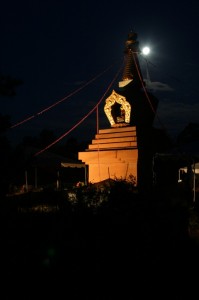Stupas
An excerpt from a teaching by H.E. Gochen Tulku Sang-ngag Rinpoche at Kunzang Palyul Choling in Sedona, Arizona on May 14, 2003. Tulku Sang-ngag is a renowned Stupa Builder and Vajrayana master. In addition to the many stupas he has helped to build and consecrate in the US, Kunzang Palyul Choling was very fortunate to have Tulku Sang Nang guide the construction of the Amitabha Stupa, to consecrate it, and to teach on the meaning of a stupa to the Sangha.
The enlightened mind of the Buddha
Before offering this Dharma teaching on the meaning of the stupa, I would like first to offer homage to the Three Jewels – the Supreme and Unsurpassed Guide, the Buddha; the teachings that the Buddha taught, the Holy Dharma; and the followers of the teaching, the Sangha. I offer homage to those three. And then to the Unsurpassed Guide, my personal teacher, who is the embodiment of all of those three in one single form. I am offering this teaching on the meaning of a stupa in accord with Jetsunma’s wishes.
That which is known as a stupa is called a “chorten” in Tibetan. A chorten means a receptacle of offerings. A stupa actually represents an outward expression of the Buddha’s enlightened body, speech and mind. First of all, we have the Buddha’s mind. The Buddha’s mind is such that it is non-composite phenomena. It has neither shape nor color, but it is all knowing. It is cognizant and lucid and yet you cannot identify it as being anything whatsoever. The Buddha’s mind is unelaborated cognizance.
In order to address the predicament that all sentient beings find themselves in, to tame those beings and bring them on the path to enlightenment, the Buddha has manifested in two specific forms in an effortless manner. In a non-artificial and natural manner, he manifests in two types of bodies. That state of the pure potentiality of enlightenment, that is the state of being a Buddha, is something, which is beyond any kind of representation. It is beyond having color or a shape or a size or any kind of form. That authentic state of enlightenment, which is yet to manifest, is the genuine stupa. It is the genuine stupa of basic space, “cho kyi ying,” which means the sphere of Dharma, the sphere of pure potential. That is what is known as the authentic stupa before the onset of manifestation. It is the potentiality. It is the actual state of enlightenment that we are talking about before it is actually manifest.
The state of basic space, the Dharmadhatu, manifests a display of appearances, which are spontaneously present, complete, and perfect. Because that basic space is an unhindered display of dynamic energy, a variety of stupas manifest in the four directions in order to benefit beings.
The state of the Buddha’s mind is such that it has the 32 qualities of enlightenment. They are the ten powers and the ten states of fearlessness and so on. Those 32 qualities of the enlightened mind of the Buddha manifest outwardly as the 32 characteristics of a physical stupa. They are actually a physical representation of those internal qualities of the Buddha’s mind.












Stupa are some of the important Buddhist sculptures that provides the feelings and environment that spread the air of calmness, joy, peace.
Stupa is the conscious connection of the spiritual and physical body. By being able to accept the spirituality of the physical body and the physicality of the spiritual body, it’s when we reach the Buddha state. Thank you for this excellent article.